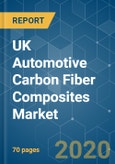Carbon fiber is a light-weight material and has high-strength characteristics that can be designed for enhanced performance in automotive applications. They offer improvement in structural, functional, or cosmetic properties. To make vehicles lighter, cleaner, safer, and more cost-effective, the leading carbon fiber suppliers are responding to the needs and expectations of the vehicle OEMs, system suppliers, and customers. Many car companies, such as BMW, Audi, GM, Honda, and Polestar have established agreements with carbon fiber material producers for mass production, and are investing in their processes to support low-cost carbon fiber manufacturing.
Growing stringent emission norms and rising fuel prices, carbon fiber, a great alternative to conventional metals, can reduce the vehicle's weight. This can improve the fuel efficiency and performance of the engine while the fiber's physical strength limits are almost twice as high as those of conventional metals. The rise in demand for electric vehicles across the country is likely to increase the penetration of carbon fiber to enhance the range of electric vehicles.
UK Automotive Carbon Fiber Composites Market Trends
Increasing Adoption of Carbon Fiber in Exterior Segment
Among applications, the exterior segment is expected to lead the market of automotive carbon fiber in terms of value and volume. The growth of this segment of the market can be attributed to the increased demand from manufacturers to produce several exterior parts, such as fenders, hoods, bumper beams, and deck lids of vehicles. Furthermore, the growing car manufacturing and export industry in the country is also supporting the market growth.Adopting carbon fiber increases the durability of vehicles, thereby ensuring a long life cycle of the parts and vehicle. The exterior parts of vehicles manufactured from composites also offer high stiffness, thereby, resulting in minimum damage to occupants in case of accidents.
Advanced materials such as carbon fiber are essential for boosting the fuel economy of modern cars all the while maintaining performance and safety. Since it takes lesser energy to accelerate a lighter object than a heavier one, lightweight materials offer great potential for increasing vehicle efficiency and fuel economy. A 10% reduction in the vehicle’s weight can transpire to a 6% to 8% increase in fuel economy. Major players are using exterior parts using carbon composites to reduce weight and improve efficiency.
- BMW and its carbon fiber producing partner the SGL Group, have spent close to USD 1 billion in establishing the supply chain for the CFRP used in the i3 and i8. Audi is also using carbon fiber to produce the rear wall of the space-frame for its A8 sedan. Even from the supply side, carbon fiber manufacturers have been ramping up their production capacities, which will further help in the adoption of carbon fiber in automobiles.
Passenger Car Segment to Hold the Majority of The Market Share
With the enactment of stringent emission norms and fuel economy standards in the European region, automobile manufacturers in UK such as BMW, Volkswagen, Audi, etc. have started using carbon fiber composites in the manufacturing of their vehicles.The government is also aiding the industry growth with more supportive policies: investment in infrastructure; broader measures to encourage uptake of the latest, low and zero-emission cars; and long-term purchase incentives to help the country grow its share in the EV market. This is expected to bolster the market prospects for carbon composited for EVs during the forecast period. For instance,
- In January 2023, the United Kingdom government released a plan for smart electric vehicles which is likely to befit the electric vehicle users through lower energy bills. A new strategy outlines ways to realize the potential of smart electric vehicle charging, including enabling drivers to use the electricity of their electric vehicle to power their homes.
The demand for carbon fiber is expected to increase during the forecast period, as companies are forming new partnerships and launching new carbon fiber technologies for the manufacturing of automotive components, in turn aiding in driving the growth of automotive carbon fiber in the European market.
UK Automotive Carbon Fiber Composites Industry Overview
The UK automotive carbon fiber market is consolidated. The top 10 players account for most of the market share. The major companies in the carbon fiber market include Hexcel Corporation, Mitsubishi Chemical Carbon Fiber and Composites Inc., SGL Carbon SE, Teijin Limited, and Toray Industries Inc. Industry participants are expected to expect intensive competition owing to aggressive strategies, including acquisitions, pricing, merges, and new product development. For instance,- In October 2023, Toray Industries, Inc., announced that it has developed TORAYCA T1200, the world’s highest strength carbon fiber with a tensile strength of 8.0 gigapascals.
Additional Benefits:
- The market estimate (ME) sheet in Excel format
- 3 months of analyst support
This product will be delivered within 2 business days.
Table of Contents
Companies Mentioned (Partial List)
A selection of companies mentioned in this report includes, but is not limited to:
- Hexcel Corporation
- General Motor Company
- MouldCam Pty Ltd
- SGL Carbon
- Toho Tenex
- Toray Industries
- Nippon Sheet Glass Company Limited
- Sigmatex
- BASF
- Mitsubishi Chemical Carbon Fiber and Composites Inc.
- Solvay
Methodology

LOADING...








